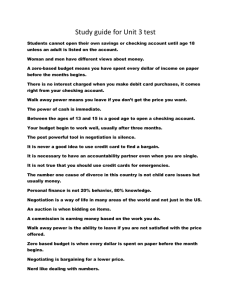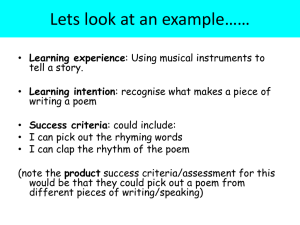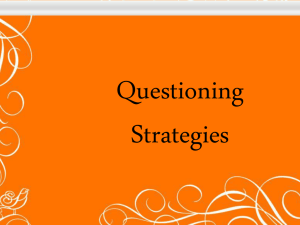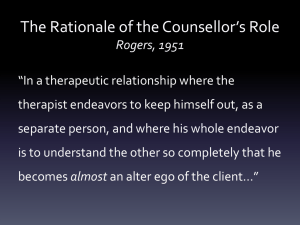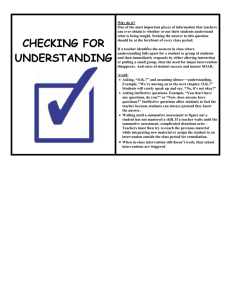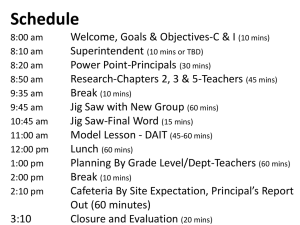Checking for Students* Understanding
advertisement
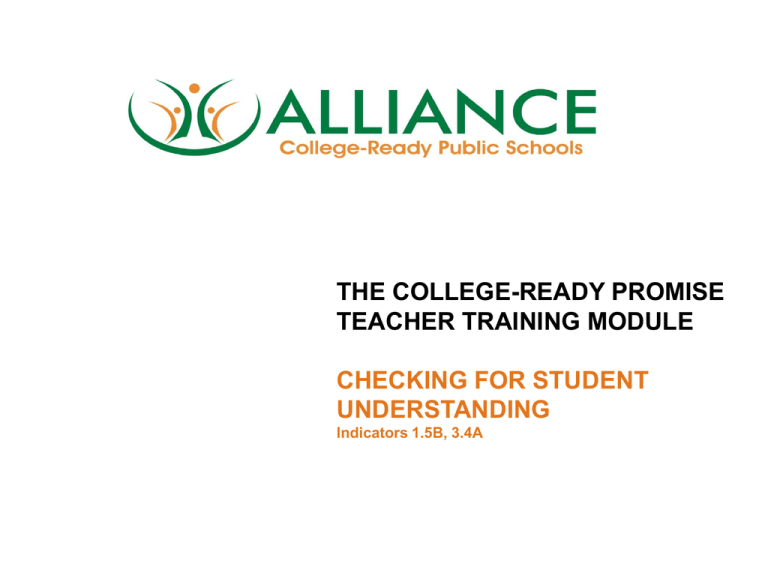
THE COLLEGE-READY PROMISE TEACHER TRAINING MODULE CHECKING FOR STUDENT UNDERSTANDING Indicators 1.5B, 3.4A 1 Rationale and Purpose TCRP Rubric Defining Teacher and Student Actions Example Strategies Incorporating into Lesson Plans Adjusting Instruction Checking for students’ understanding Engages students Provides real-time data on student understanding Allows the teacher to determine effectiveness of lesson/instructions Allows the teacher to adjust instruction To assess students’ prior understanding To gauge students’ understanding of concepts during a lesson To determine whether students understand procedures To assess students prior to guided practice or independent practice To delve deeper into students’ understandings and misconceptions Frequency/Effect on Student Achievement Checking for Understanding Exit Slips Quizzes Unit Tests Benchmark Assessments Final Exams CST High Stakes/Public Perception 1.5 B) Progression of Assessments Level 1 Level 2 Level 3 Level 4 No assessment or a single assessment is planned at the conclusion of the lesson. Multiple assessments are planned. However, they are not sequenced in a way to provide meaningful information about student progression towards mastery of the learning objective(s). Multiple assessments are planned and build on each other. They are sequenced throughout the lesson in order to provide meaningful information about student progression towards mastery of the learning objective(s). All of level 3 and… Assessments are sequenced to ensure student progression towards mastery. Plans provide opportunities for student choice in, or design of, assessment methods. 3.4 A) Checking for understanding and adjusting instruction: Level 1 Level 2 Level 3 The teacher does not check for students’ understanding of the learning objectives during the lesson and/or does not adjust instruction. The teacher has limited techniques to accurately check for students’ understanding of the learning objectives and/or does not use the information gained to make adjustments in instruction. The teacher uses frequent and varied techniques to accurately monitor students’ progress toward the learning objectives and immediately adjusts instruction to meet students’ learning needs Level 4 All of level3 and… Students selfassess and suggest adjustments in the instruction to meet their needs. Teacher question is phrased with several options, i.e. Multiple choice Agree/Disagree True/False All students respond and provide teacher with feedback Teacher should check for student understanding at least once every 15 minutes Teacher utilizes student responses to: Probe reasons for student responses Determine next steps for instruction By using different techniques of oral language Accountable talk Value lineups Retellings Think-pair-share Misconception analysis Whip around How can teachers effectively increase students’ understanding? By using different types of questioning techniques Response cards Hand signals Electronic Response Systems ReQuest Socratic seminar By using quizzes and tests By using a variety of writing assessments Interactive writing Read-write-pair-share Summary writing Multiple choice Short answer True or False Essay Accountable Talk Students are taught how to be accountable with each other (staying on task, using accurate and appropriate information for the topic, and thinking deeply about what their partner says) to forward the conversation and deepen their understanding of the topic at hand. One way to teach accountable talk is through reciprocal teaching. Value Lineups Students develop in-depth knowledge by enabling them to explore core concepts and understanding problems by first analyzing their beliefs and then listening to positions held by others. (See depth and complexity.) Retellings Students process large segments of text, think about the sequence of ideas or events and their importance, and then have students orally summarize what they understand. Teacher should take notes as students retell. Think-Pair-Share Students discuss their responses with a partner before sharing out with the whole class. Partners can also pair up with another set of partners to discuss in a quad before sharing out with the class. Misconception Analysis Students have an opportunity to discuss, often in small groups, misunderstandings they have about the topic at hand. Teacher should circulate and take notes on what the students are saying. Whip Around Students make a list of at least three items in response to a question; every student then stands up and as one student calls out the answer, other students cross that item off their list. When all items are crossed off their list, that student may sit. Practice: Whip Around What is the purpose or the rationale of Checking for Understanding? Write 3 answers to the question. Purpose To assess students’ prior understanding To gauge students’ understanding of concepts during a lesson To determine whether students understand procedures To assess students prior to guided practice or independent practice To delve deeper into students’ understandings and misconceptions Rationale Checking for students’ understanding: Engages students Provides real-time data on student understanding Allows the teacher to determine effectiveness of lesson/instructions Allows the teacher to adjust instruction Response Cards Index cards, signs, dry erase boards, magnetic boards, or other items are simultaneously held up by all students in class to indicate their responses to a question or problem. Hand Signals Thumbs up, thumbs sideways, and thumbs down to indicate understanding, confusion, or a misunderstanding. Electronic Response System Electronic clickers can display multiple-choice responses in chart form so students and teacher get immediate feedback on each problem. Reciprocal Questioning (ReQuest) Students ask and answer each other’s questions as they read. Socratic Seminar A group of learners engages in conversation and a series of questions. Reciprocal Questioning Read the TCRP rubric descriptors of practice for Standard 3.4, Indicator A. With a partner, ask and answer clarifying questions. Level 1 Level 2 Level 3 The teacher does not check for students’ understanding of the learning objectives during the lesson and/or does not adjust instruction. The teacher has limited techniques to accurately check for students’ understanding of the learning objectives and/or does not use the information gained to make adjustments in instruction. The teacher uses frequent and varied techniques to accurately monitor students’ progress toward the learning objectives and immediately adjusts instruction to meet students’ learning needs Level 4 All of level3 and… Students selfassess and suggest adjustments in the instruction to meet their needs. Interactive Writing Allowing students to share the pen or dry erase marker with the teacher in whole or small groups. Read-Write-Pair-Share Students read the material, write in response to the information, engage in a partner conversation about they’ve read and written, and then share their ideas with the whole class. Quick Write-Pair-Share Several times throughout the lesson, students are given 1 minute (or 2 minutes) to write about what they’ve learned. They then engage in a partner conversation about they’ve written, and then share their ideas with the whole class. Summary Writing Students write a summary about what they have read, viewed, done, or learned. Could be used as an exit slip or as a Do Now. Practice: Quick Write-Pair-Share Take one minute to write about what you’ve learned so far in this presentation. When the time is up, share your writing with a partner. Multiple Choice Gauges students’ understanding fairly quickly. Short Answer Measures if students can accurately recall specific information. Can also be used to measure higher cognitions. True or False Determine if students understand the correctness of statements of fact, if they agree with opinions, if they can define terms, or if they understand a principle. Essays Requires students to consolidate their understanding of a topic, organize their thinking, and present it by providing an opportunity for students to synthesize or evaluate information. Practice: Multiple Choice and Short Answer In indicator 3.4A, at a level 2 practice the teacher uses ______________ techniques to accurately check for students’ understanding. a) Frequent b) Varied c) Limited The four categories of checking for understanding are writing, questioning, quizzes and ______________________. a) Response cards b) Oral language c) Quick Write Practice: Multiple Choice and Short Answer Teachers should check for understanding at least every ____ minutes. a) 15 b) 30 c) Only as needed The type of assessment that has the most direct effect on student achievement is _______________________________. Identify which strategies fit your style Determine when during the lesson the checks should be included Write out the questions to ask students Over time, as you become comfortable with using them, the need to plan out your strategies in detail will decrease. Checking for Understanding oral language quizzes After I present the Powerpoint and have given students the information about the topic, I will have them do a WHIP AROUND questioning techniques Before students begin their group work, I will ask questions and students will hold up their RESPONSE CARDS writing When students are finished with their group work, I will have them WRITE A SUMMARY of what they learned. Students will share their summary in a pairshare. Before students exit the class, they will answer 5 MULTIPLE CHOICE questions. Plan your checks at strategic points in your lesson, so if you need to re-teach a few students, the remainder of the class can continue independent or group work. Anticipate that not all students will demonstrate understanding. Budget time in your lesson plan to accommodate re-teaching. If only a few students don’t understand, immediately bring them forward for re-teaching. Have at least two more strategies to use. Try teaching with different modalities. If half the class doesn’t understand, try having students who do understand explain it in their own words. If that doesn’t work, allow the proficient students to continue their work and you re-teach the students who still need it. Have at least two more strategies to use. Try teaching to different modalities. If most of the class doesn’t understand, group the students by readiness or common misunderstandings and assign the few students who do understand to re-teach a group. You work with the most intensive learners. As students show understanding, they can continue with their independent work. Eventually you will have only a few students to call up for further re-teaching. Have several strategies ready, including teaching to the students’ learning modalities or to Garner’s multiple intelligences. Checking for Understanding oral language quizzes After I present the Powerpoint and have given students the information about the topic, I will have them do a WHIP AROUND questioning techniques Before students begin their group work, I will ask questions and students will hold up their RESPONSE CARDS writing When students are finished with their group work, I will have them WRITE A SUMMARY of what they learned. Students will share their summary in a pairshare. Before students exit the class, they will answer 5 MULTIPLE CHOICE questions. What did I learn? How could this module be improved? What do I still need to know? What did I learn that I will use tomorrow?

